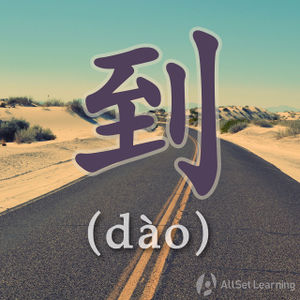Difference between revisions of "Expressing "until" with "dao""
m (Text replace - "{{Grammar Box}} " to "{{Grammar Box}} ") |
(→Examples: 11:30 → 12:30) |
||
| Line 23: | Line 23: | ||
<div class="liju"> | <div class="liju"> | ||
| − | * 我 昨天晚上 工作 <strong>到</strong> <em>十二点半</em>。<span class="trans">I worked until | + | * 我 昨天晚上 工作 <strong>到</strong> <em>十二点半</em>。<span class="trans">I worked until 12:30 last night.</span> |
* 请 你 坐 <strong>在</strong> <em>我 旁 边儿</em>。<span class="trans">Please come and sit next to me.</span> | * 请 你 坐 <strong>在</strong> <em>我 旁 边儿</em>。<span class="trans">Please come and sit next to me.</span> | ||
* 我 今天早上 发了 一封 电子邮件 <strong>给</strong> <em>你</em>。<span class="trans">I sent an e-mail to you this morning.</span> | * 我 今天早上 发了 一封 电子邮件 <strong>给</strong> <em>你</em>。<span class="trans">I sent an e-mail to you this morning.</span> | ||
Revision as of 17:12, 22 September 2014
-
Level
-
Similar to
-
Used for
-
Keywords
One of the cool features of Chinese is complements, and in this article we introduce a few of them.
Structure
One kind of complement in Chinese involves putting 到, 给 or 在 after the verb. These are used to indicate direction, target and location, respectively.
- 到 (dào) indicates that the action has obtained a goal or a certain state. Any verb that uses the complement 见 can also use 到.
- 给 (gěi) indicates that you have passed something from one person to another.
- 在 (zài) indicates a person or thing coming to a certain place. It is usually followed my a location or a place.
Subject + Verb + 到 / 给 / 在 ...
Examples
- 我 昨天晚上 工作 到 十二点半。I worked until 12:30 last night.
- 请 你 坐 在 我 旁 边儿。Please come and sit next to me.
- 我 今天早上 发了 一封 电子邮件 给 你。I sent an e-mail to you this morning.
See also
Sources and further reading
Books
- New Practical Chinese Reader 2 (新实用汉语课本2) (pp. 240) →buy
- Chinese Grammar Without Tears (简明汉语语法学习手册) (p.93-95) →buy



